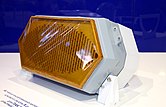Byelka (radar): Difference between revisions
Strak Jegan (talk | contribs) No edit summary |
Strak Jegan (talk | contribs) |
||
| Line 27: | Line 27: | ||
==Design== |
==Design== |
||
The radar is a part of Sh121 multifunctional integrated radio electronic system (MIRES) on board the Su-57. The N036 radar system is developed by Tikhomirov NIIP Institute and consists of a main nose-mounted [[X-band]] AESA radar with 1,552 T/R modules, designated the N036-1-01,<ref name="Air International October 2013 p79"/> and two smaller X-band AESA radars with 358 T/R modules mounted on the sides of the forward fuselage designated N036B-1-01. The suite also has two N036L-1-01 [[L-band]] arrays on the wing's leading edge extensions that are not only used for friend-or-foe identification but also for electronic warfare purposes. Computer processing of the X- and L-band signals enable the systems information to be significantly enhanced. Ability to track 62 targets and shoot 16 simultaneously. Ability to engage 4 targets on land simultaneously. The L402 "Himalayas" electronic countermeasures ([[Electronic countermeasure|ECM]]) suite made by the [[KNIRTI]] institute uses both its own arrays and that of the N036 radar |
The radar is a part of Sh121 multifunctional integrated radio electronic system (MIRES) on board the Su-57. The N036 radar system is developed by Tikhomirov NIIP Institute and consists of a main nose-mounted [[X-band]] AESA radar with 1,552 T/R modules, designated the N036-1-01,<ref name="Air International October 2013 p79"/> and two smaller X-band AESA radars with 358 T/R modules mounted on the sides of the forward fuselage designated N036B-1-01. The suite also has two N036L-1-01 [[L-band]] arrays on the wing's leading edge extensions that are not only used for friend-or-foe identification but also for electronic warfare purposes. Computer processing of the X- and L-band signals enable the systems information to be significantly enhanced. Ability to track 62 targets and shoot 16 simultaneously. Ability to engage 4 targets on land simultaneously. The L402 "Himalayas" electronic countermeasures ([[Electronic countermeasure|ECM]]) suite made by the [[KNIRTI]] institute uses both its own arrays and that of the N036 radar.<ref name="Air International October 2013 p79">Butowski 2013, p. 79.</ref> |
||
<gallery widths="166px" heights="136px"> |
<gallery widths="166px" heights="136px"> |
||
Revision as of 12:35, 20 June 2018
| N036 Byelka | |
|---|---|

| |
| NIIP's Byelka AESA radar for the Su-57 on display at the 2009 MAKS airshow | |
| Role | X-Band, L-Band active electronically scanned array |
| National origin | Russia |
| Manufacturer | Tikhomirov NIIP |
| Designer | Tikhomirov NIIP |
| Status | Testing |
| Primary user | Russian Air Force |
| Developed from | Irbis-E |
N036 Byelka (Template:Lang-ru, literally Squirrel) is an advanced active electronically scanned array radar system developed by Tikhomirov NIIP for the fifth generation Sukhoi Su-57 fighter aircraft. NIIP developed the radar from the N035 Irbis-E that is fitted on the Sukhoi Su-35 multirole aircraft.[1]
Design
The radar is a part of Sh121 multifunctional integrated radio electronic system (MIRES) on board the Su-57. The N036 radar system is developed by Tikhomirov NIIP Institute and consists of a main nose-mounted X-band AESA radar with 1,552 T/R modules, designated the N036-1-01,[2] and two smaller X-band AESA radars with 358 T/R modules mounted on the sides of the forward fuselage designated N036B-1-01. The suite also has two N036L-1-01 L-band arrays on the wing's leading edge extensions that are not only used for friend-or-foe identification but also for electronic warfare purposes. Computer processing of the X- and L-band signals enable the systems information to be significantly enhanced. Ability to track 62 targets and shoot 16 simultaneously. Ability to engage 4 targets on land simultaneously. The L402 "Himalayas" electronic countermeasures (ECM) suite made by the KNIRTI institute uses both its own arrays and that of the N036 radar.[2]
-
N036L-1-01 AESA radar
-
N036B-1-01B AESA radar on display at the 2013 MAKS airshow
References
Bibliography
- Butowski, Piotr. "Raptorski's Maiden Flight". Air International, Vol. 78, No 3, March 2010, pp. 30–37. Stamford, UK: Key Publishing.
- Butowski, Piotr. "T-50 Turning and Burning over Moscow". Air International, Vol. 85, No 4, October 2013, pp. 79–82. Stamford, UK: Key Publishing.


